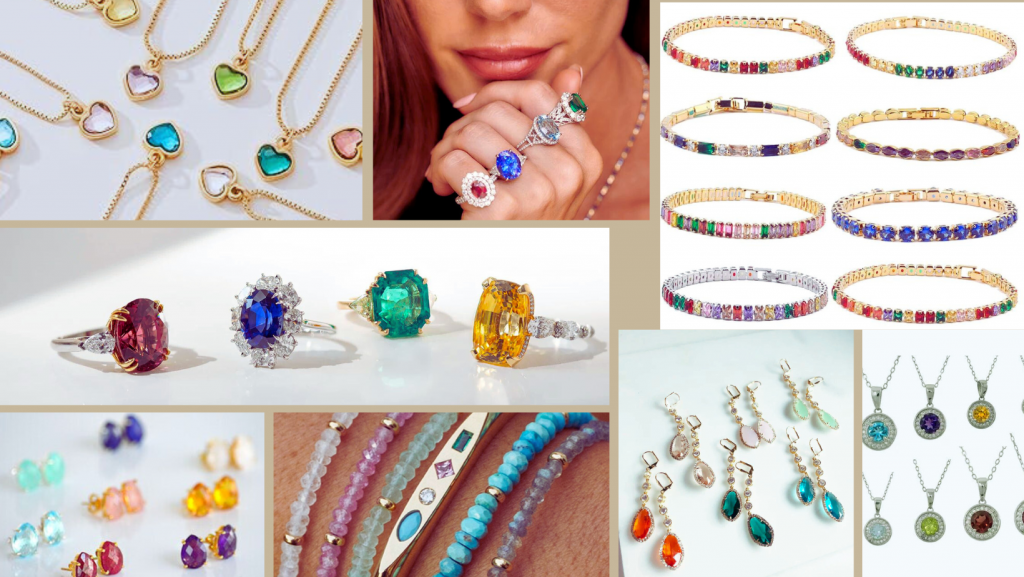Introduction to Birthstones
Birthstones have fascinated people for centuries, serving as symbols of identity, protection, and personal expression. In this comprehensive guide, we’ll delve into the captivating world of birthstones, exploring their history, significance, and cultural importance.

What Are Birthstones?
Birthstones are gemstones that are associated with specific months of the year. Each month is linked to one or more gemstones, and individuals born in that month are traditionally assigned their corresponding birthstone. These gemstones hold special meaning and are often used in jewelry to celebrate birthdays and other significant occasions.
History and Origins
The concept of birthstones dates back to ancient times, with early civilizations attributing mystical properties and significance to gemstones. The practice of wearing birthstones can be traced to the breastplate of Aaron, a religious garment mentioned in the Bible, which featured twelve gemstones representing the twelve tribes of Israel.
Significance and Symbolism
Birthstones are believed to possess various qualities and symbolism that can influence the lives of those who wear them. For example, they are often associated with qualities such as luck, protection, and healing. Many cultures have their own interpretations of the symbolic meaning of birthstones, adding to their allure and significance.
Cultural Importance
Throughout history, birthstones have held cultural significance in different societies around the world. They are often used in traditional ceremonies and rituals, symbolizing everything from purity and prosperity to love and fidelity. In some cultures, specific gemstones are believed to bring good fortune or ward off negative energy.
List of Birthstones
In this section, we’ll explore the traditional and modern birthstones associated with each month of the year. Whether you’re seeking a meaningful gift or looking to personalize your jewelry collection, understanding the birthstones linked to each month can add a special touch to any occasion.
Traditional Birthstones by Month
- January – Garnet: Symbolizing friendship and trust, garnet is a deep red gemstone often associated with protection and vitality.
- February – Amethyst: Known for its stunning purple hues, amethyst is believed to promote clarity of mind and spiritual growth.
- March – Aquamarine: With its serene blue color reminiscent of the ocean, aquamarine is associated with courage, peace, and serenity.
- April – Diamond: As the ultimate symbol of love and commitment, diamonds are revered for their brilliance and timeless elegance.
- May – Emerald: Representing rebirth and fertility, emeralds are prized for their rich green color and association with growth and prosperity.
- June – Pearl, Alexandrite, Moonstone: June babies have three birthstones to choose from, each with its own unique beauty and symbolism. Pearls symbolize purity and wisdom, alexandrite represents luck and good fortune, and moonstone is associated with intuition and balance.
- July – Ruby: Symbolizing passion and vitality, rubies are prized for their vibrant red color and are often associated with love and desire.
- August – Peridot, Sardonyx: August has two birthstones, peridot, a lime green gemstone associated with strength and healing, and sardonyx, a stone known for protection and courage.
- September – Sapphire: Renowned for its deep blue color, sapphire is believed to symbolize wisdom, loyalty, and nobility.
- October – Opal, Tourmaline: October babies have the option of two birthstones. Opal is known for its iridescent play-of-color and symbolizes creativity and inspiration, while tourmaline comes in a variety of colors and is associated with strength and balance.
- November – Topaz, Citrine: November birthstones offer a range of warm hues. Topaz is available in various colors, with blue being the most common, and is associated with strength and healing. Citrine, with its sunny yellow color, symbolizes joy, success, and abundance.
- December – Turquoise, Tanzanite, and Zircon: December boasts three birthstones. Turquoise is known for its sky-blue color and is associated with protection and good fortune. Tanzanite is a rare gemstone with a striking blue-purple hue, symbolizing transformation and spiritual growth. Zircon, available in various colors, symbolizes wisdom, honor, and prosperity.
Meanings and Symbolism
In this section, we’ll explore the meanings and symbolism behind birthstones, shedding light on the rich cultural and historical significance associated with these precious gems.
Understanding Birthstone Meanings
Each birthstone carries its own unique meaning and symbolism, often rooted in ancient beliefs and traditions. Understanding the significance of your birthstone can add depth and personal meaning to your jewelry or gift-giving experience.
Garnet (January)
Garnet, the birthstone for January, symbolizes friendship, trust, and protection. It is believed to bring vitality and strength to the wearer, serving as a talisman against negative energies.

Amethyst (February)
Amethyst, associated with February, is prized for its stunning purple color and is believed to promote clarity of mind and spiritual growth. It symbolizes peace, stability, and inner strength.

Aquamarine (March)
March’s birthstone, aquamarine, is reminiscent of the tranquil waters of the sea. It symbolizes courage, peace, and serenity, making it an ideal gemstone for promoting emotional balance and harmony.

Diamond (April)
As the ultimate symbol of love and commitment, the diamond represents purity, innocence, and everlasting love. It is often used in engagement rings to symbolize the eternal bond between partners.

Emerald (May)
The emerald, birthstone for May, is associated with rebirth, fertility, and growth. Its rich green color symbolizes renewal and vitality, making it a popular choice for celebrating new beginnings.
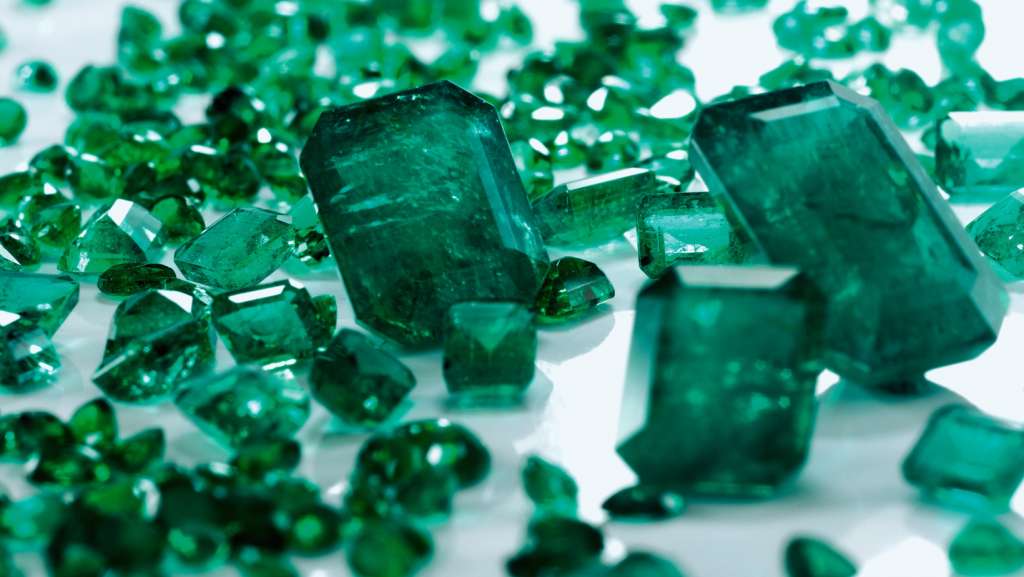
Pearl (June)
June’s birthstone, the pearl, symbolizes purity, wisdom, and innocence. It is believed to promote emotional balance and enhance the wearer’s integrity and sincerity.

Ruby (July)
The ruby, symbolizing passion and vitality, is associated with love, desire, and courage. Its vibrant red color symbolizes strength and energy, making it a powerful gemstone for inspiring passion and motivation.

Peridot (August)
August’s birthstone, peridot, is a symbol of strength, healing, and protection. Its vibrant green color is believed to promote positivity and ward off negative energies.

Sapphire (September)
The sapphire, associated with September, symbolizes wisdom, loyalty, and nobility. Its deep blue color represents sincerity, truth, and faithfulness, making it a popular choice for engagement rings and other meaningful jewelry pieces.

Opal (October)
October’s birthstone, the opal, is known for its iridescent play-of-color and is associated with creativity, inspiration, and imagination. It symbolizes hope and optimism, making it a beloved gemstone for artists and dreamers.
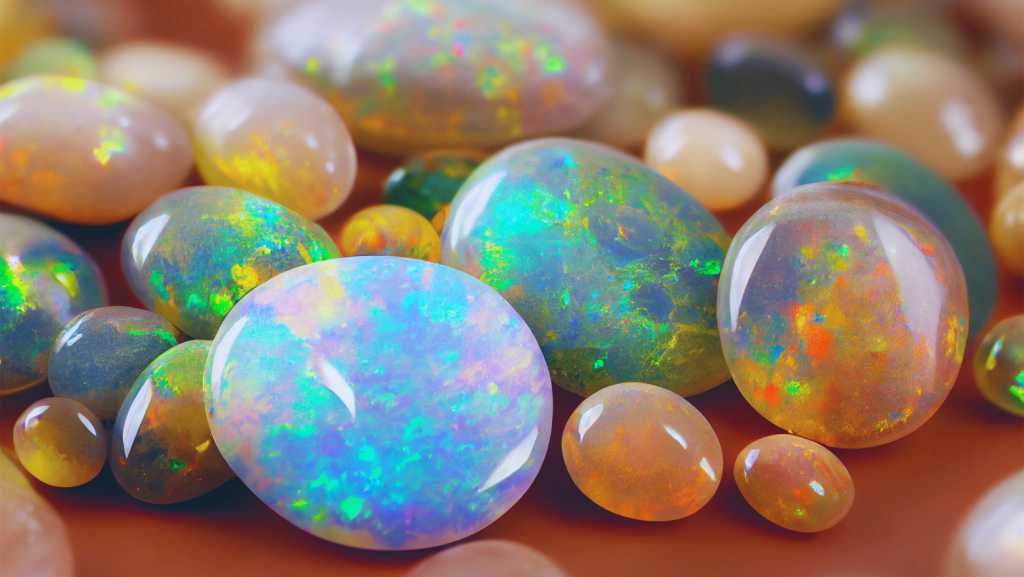
Topaz (November)
November’s birthstone, topaz, comes in a variety of colors, with blue being the most common. It symbolizes strength, healing, and protection, making it a popular choice for those seeking courage and resilience.
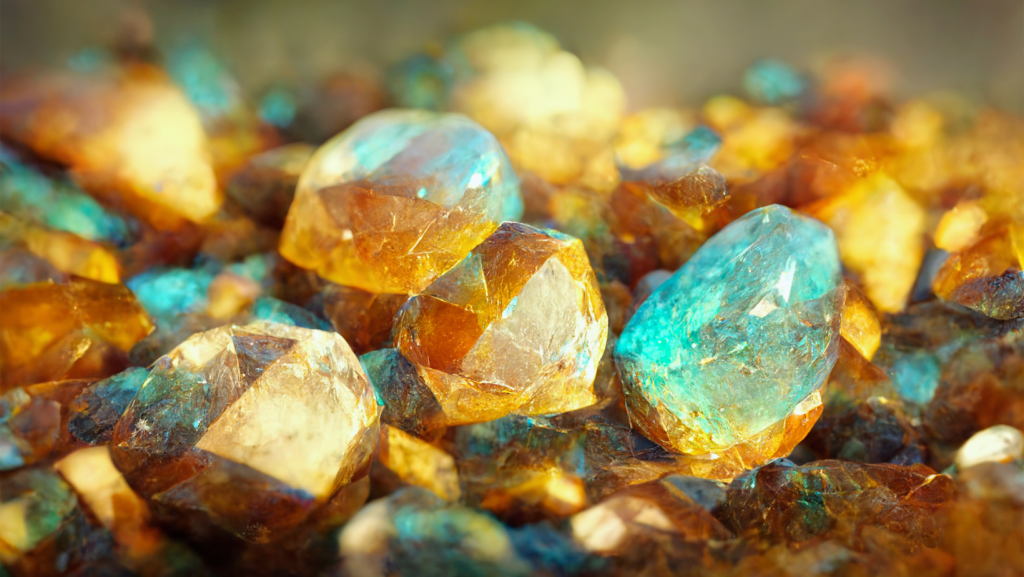
Turquoise (December)
The turquoise, birthstone for December, symbolizes protection, good fortune, and success. Its sky-blue color is believed to bring calmness and clarity to the wearer, promoting inner peace and emotional balance.

Physical Characteristics
In this section, we’ll delve into the physical characteristics of birthstones, exploring their unique properties, colors, and qualities that make each gemstone distinctive and prized.
Color Variations
One of the most defining characteristics of birthstones is their color variation. Each birthstone exhibits a range of hues, from deep and vibrant to subtle and delicate, making them versatile and appealing for a variety of jewelry designs.
Clarity and Transparency
Another important aspect of birthstones is their clarity and transparency. Some birthstones, like diamonds and aquamarines, are prized for their clarity, which enhances their brilliance and sparkle. Others, like opals and pearls, exhibit a unique play-of-color or iridescence, adding to their allure and beauty.
Cut and Shape
The cut and shape of a birthstone can greatly impact its appearance and brilliance. Birthstones are often cut into various shapes, including round, oval, pear, and emerald-cut, to maximize their beauty and sparkle. The choice of cut and shape depends on the specific characteristics of each gemstone and the desired style of the jewelry piece.
Quality Considerations
When selecting a birthstone, it’s important to consider factors such as color intensity, clarity, cut, and size, which collectively determine the overall quality and value of the gemstone. Higher quality birthstones typically exhibit vivid color, excellent clarity, and precision-cut facets that enhance their beauty and appeal.
Durability and Hardness
In this section, we’ll explore the durability and hardness of birthstones, two important factors that determine their suitability for different types of jewelry and everyday wear.
Durability
Durability refers to a gemstone’s ability to withstand wear, tear, and damage over time. It is an essential consideration when choosing birthstone jewelry, especially for pieces that will be worn regularly or subjected to everyday activities.
Hardness
Hardness is a measure of a gemstone’s resistance to scratching and abrasion. It is measured on the Mohs scale, which ranks minerals from 1 (softest) to 10 (hardest). Gemstones with higher hardness ratings are less likely to scratch or become damaged during wear.
Comparing Durability and Hardness
When comparing birthstones for durability and hardness, it’s important to consider their specific characteristics and properties. For example:
- Diamonds, with a hardness of 10 on the Mohs scale, are the hardest gemstones and are highly resistant to scratching and abrasion. They are an excellent choice for engagement rings and everyday wear.
- Sapphires and rubies, both varieties of corundum, have a hardness of 9 on the Mohs scale, making them extremely durable and suitable for all types of jewelry, including rings and bracelets.
- Emeralds, while prized for their beauty and color, are relatively softer gemstones with a hardness of 7.5 to 8 on the Mohs scale. They require gentle care and are best suited for earrings and pendants rather than rings.
- Pearls, although not measured on the Mohs scale, are relatively soft and prone to scratching. They require careful handling and should be stored separately from other jewelry to prevent damage.
Availability and Sourcing
In this section, we’ll explore the availability and sourcing of birthstones, shedding light on the geographic sources, ethical considerations, and factors that influence the availability of these precious gems.

Geographic Sources
Birthstones are sourced from various regions around the world, each known for producing specific gemstones. For example:
- Diamonds: Diamonds are sourced from countries such as Botswana, Russia, Canada, and Australia, among others.
- Emeralds: Colombia is renowned for producing some of the world’s finest emeralds, while other sources include Brazil, Zambia, and Afghanistan.
- Rubies: Myanmar (formerly Burma) is famous for its high-quality rubies, although rubies are also found in other countries such as Thailand, Sri Lanka, and Cambodia.
- Sapphires: Sapphires are found in numerous locations, including Sri Lanka, Madagascar, Myanmar, and Australia.
Ethical Considerations
Ethical sourcing has become increasingly important in the gemstone industry, with consumers seeking transparency and accountability in the sourcing process. Ethical considerations include:
- Conflict-Free: Ensuring that gemstones are not sourced from regions affected by armed conflict or human rights abuses.
- Fair Trade: Supporting fair trade practices that benefit local communities and ensure fair wages and working conditions for miners and workers.
- Environmental Impact: Minimizing the environmental impact of mining activities and promoting sustainable practices that protect ecosystems and natural resources.
Factors Affecting Availability
Several factors can influence the availability of birthstones, including:
- Mining Regulations: Government regulations and policies governing mining activities can impact the availability of gemstones from certain regions.
- Market Demand: Fluctuations in market demand and consumer preferences can affect the availability of specific gemstones, leading to fluctuations in supply and pricing.
- Geological Factors: Geological conditions and geological events such as volcanic activity can influence the formation and availability of gemstone deposits.
Cultural Significance
In this section, we’ll explore the cultural significance of birthstones, examining their role in various traditions, beliefs, and practices across different cultures and civilizations.
Birthstones in Ancient Cultures
The use of birthstones dates back to ancient civilizations, where gemstones were believed to possess magical powers and symbolic significance. For example:
- Ancient Egypt: The ancient Egyptians associated certain gemstones with specific deities and believed that wearing these stones would offer protection and bring good fortune.
- Ancient Greece and Rome: In ancient Greece and Rome, birthstones were associated with astrological signs and were believed to influence the destiny and personality traits of individuals born under each sign.
Birthstone Traditions Around the World
Birthstone traditions vary across different cultures and regions, with each culture attributing unique meanings and symbolism to specific gemstones. Some examples include:
- Eastern Cultures: In many Eastern cultures, birthstones are believed to have healing properties and are used in traditional medicine and spiritual practices.
- Native American Traditions: Native American cultures have their own traditions surrounding birthstones, with certain stones believed to be sacred and used in ceremonial rituals.
Folklore and Myths
Birthstones are often associated with folklore and myths that have been passed down through generations. These stories add to the mystique and cultural significance of birthstones, shaping beliefs and practices surrounding these precious gems.
Metaphysical Properties
In this section, we’ll explore the metaphysical properties associated with birthstones, examining the spiritual and healing attributes believed to be inherent in these precious gems.
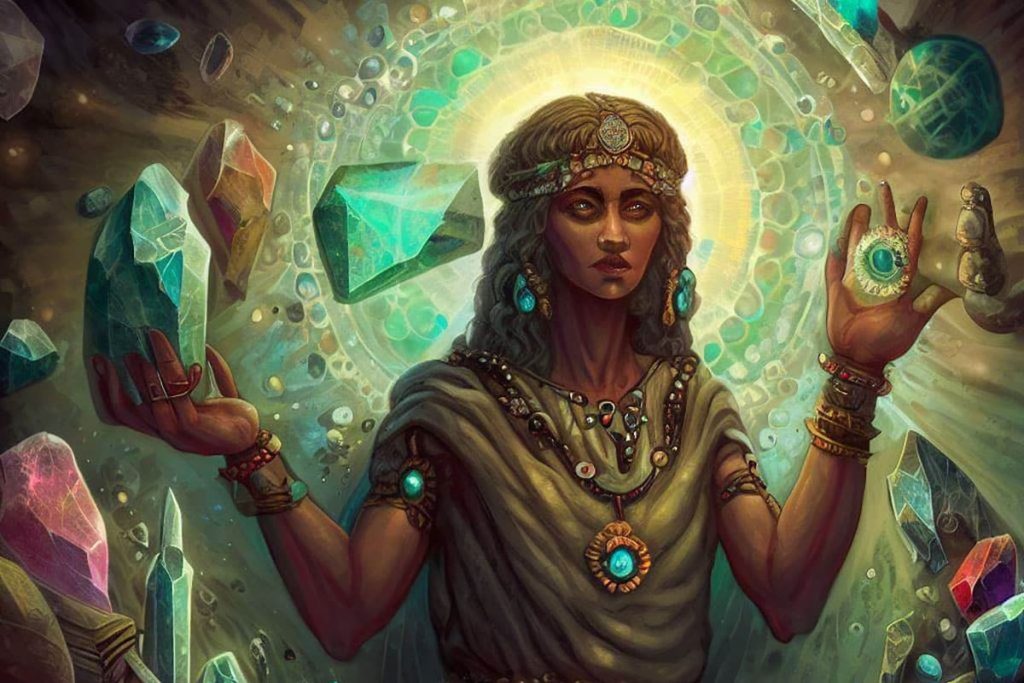
Healing and Spiritual Beliefs
Birthstones have long been associated with healing and spiritual properties, with each gemstone believed to possess unique energies and qualities that can influence the mind, body, and spirit. Many people believe that wearing or carrying their birthstone can enhance specific aspects of their lives and promote overall well-being.
Common Metaphysical Properties
While the metaphysical properties attributed to each birthstone vary across different cultures and belief systems, there are some common associations that are widely recognized. For example:
- Amethyst: Known as the stone of spirituality and contentment, amethyst is believed to promote peace, balance, and inner strength. It is often used in meditation and spiritual practices to enhance intuition and spiritual awareness.
- Turquoise: Turquoise is considered a protective stone that wards off negative energy and promotes mental clarity and emotional healing. It is also associated with communication and creativity, making it a popular choice for artists and writers.
- Emerald: Emerald is believed to enhance love, compassion, and harmony in relationships. It is also associated with abundance and prosperity, making it a powerful stone for attracting wealth and success.
Crystal Healing Practices
In crystal healing practices, birthstones are often used to balance and align the body’s energy centers, known as chakras. Each birthstone is believed to resonate with a specific chakra, influencing its energy flow and promoting overall health and well-being.
Popularity and Trends
In this section, we’ll explore the popularity and trends surrounding birthstones, examining their significance in the world of jewelry and fashion, as well as emerging trends that influence consumer preferences.
Traditional Appeal
Birthstones have long held a special place in the hearts of jewelry enthusiasts and gift-givers alike. Their timeless appeal and personal significance make them popular choices for a wide range of jewelry pieces, from rings and necklaces to bracelets and earrings.
Cultural Significance
Birthstones are deeply rooted in cultural traditions and beliefs, contributing to their enduring popularity across different societies and regions. Many people value the connection to their birth month and the symbolic meaning associated with their birthstone, making it a meaningful choice for personal adornment and gifting.
Modern Trends
While traditional birthstones continue to hold sway, modern trends in jewelry design have also influenced the popularity of birthstones. Contemporary designers are incorporating birthstones into innovative and stylish pieces that appeal to a younger, fashion-forward audience.
Customization and Personalization
Personalization has become a major trend in the jewelry industry, with consumers seeking unique and meaningful pieces that reflect their individual style and personality. Birthstones offer a perfect opportunity for customization, allowing individuals to create personalized jewelry that celebrates their birth month and unique identity.
Emerging Trends
In recent years, certain birthstones have experienced a surge in popularity due to emerging trends and cultural influences. For example, millennials and Gen Z consumers have shown a growing interest in alternative birthstones, such as lab-grown diamonds and unconventional gemstones, reflecting their values of sustainability and individuality.
Care and Maintenance
In this section, we’ll discuss the care and maintenance of birthstones, offering tips and guidelines to help you keep your precious gemstones looking their best for years to come.
General Care Tips
Proper care is essential to maintain the beauty and integrity of your birthstone jewelry. Here are some general care tips to keep in mind:
- Avoid Harsh Chemicals: Avoid exposing your birthstone jewelry to harsh chemicals such as chlorine, bleach, and household cleaners, as they can damage the gemstone and metal settings.
- Remove Jewelry During Activities: Remove your birthstone jewelry before engaging in activities such as swimming, exercising, or household chores to prevent damage and minimize the risk of loss or breakage.
- Store Jewelry Properly: Store your birthstone jewelry in a clean, dry place away from direct sunlight and moisture. Use individual pouches or compartments to prevent scratching and tangling.
Cleaning Techniques
Regular cleaning is essential to maintain the brilliance and luster of your birthstone jewelry. Here are some cleaning techniques to keep your gemstones sparkling:
- Gentle Cleaning Solution: Use a mild detergent or dish soap diluted in warm water to clean your birthstone jewelry. Soak the jewelry for a few minutes, then gently scrub with a soft brush or cloth to remove dirt and debris.
- Avoid Ultrasonic Cleaners: Avoid using ultrasonic cleaners or steam cleaners for birthstones that are susceptible to damage, such as pearls and opals. These cleaning methods can cause discoloration or damage to certain gemstones.
- Professional Cleaning: For deep cleaning and maintenance, consider taking your birthstone jewelry to a professional jeweler for professional cleaning and inspection.
Specific Care for Different Birthstones
Different birthstones may require specific care and maintenance due to their unique properties. Here are some specific care tips for common birthstones:
- Diamonds: Diamonds are durable and can be cleaned using a gentle cleaning solution and a soft brush. Avoid exposing diamonds to extreme heat or sudden temperature changes.
- Emeralds: Emeralds are relatively soft and porous gemstones that require gentle care. Avoid exposure to heat and chemicals, and clean with a soft cloth and mild detergent.
- Pearls: Pearls are delicate gemstones that require special care. Avoid exposure to harsh chemicals, perfumes, and cosmetics, and clean with a soft cloth dampened with water.
Conclusion
In conclusion, birthstones hold a special place in the world of jewelry and gemstones, offering not only beauty but also rich symbolism, cultural significance, and personal meaning. From ancient traditions to modern trends, birthstones continue to captivate people around the world with their unique properties and allure.
Throughout this guide, we’ve explored the fascinating world of birthstones, from their historical origins to their contemporary significance. We’ve delved into their meanings and symbolism, physical characteristics, durability, sourcing, cultural importance, popularity, and maintenance, providing readers with a comprehensive understanding of these precious gems.
Whether you’re selecting a birthstone for yourself or choosing a meaningful gift for a loved one, understanding the intricacies of birthstones can help you make informed decisions and appreciate the beauty and significance of these timeless treasures.
As you embark on your journey with birthstones, remember to care for your gemstones with love and attention, following proper maintenance techniques to preserve their beauty and integrity for generations to come.
We hope this article has been informative and insightful, enriching your appreciation for the captivating world of birthstones. Whether you’re drawn to the timeless elegance of diamonds, the vibrant colors of rubies and sapphires, or the mystical allure of opals and pearls, may your journey with birthstones be filled with joy, meaning, and beauty.
Thank you for joining us on this exploration of birthstones. May your birthstone jewelry continue to bring you joy, luck, and happiness for many years to come.





